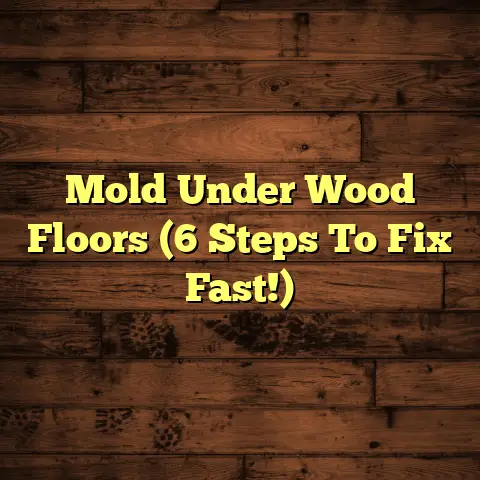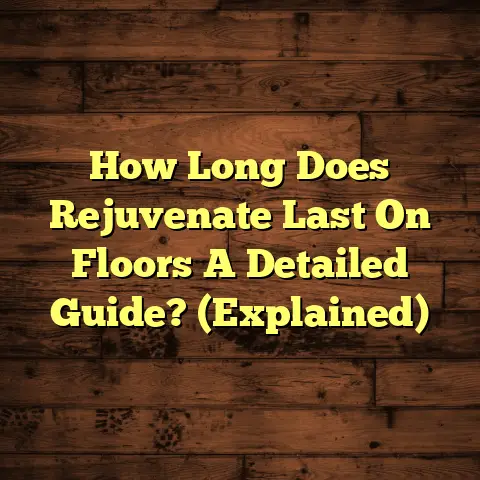Hardwood Plank Width: Best Choice? (7 Size Guide)
Best Choice? (7 Size Guide)
Choosing the width of hardwood planks for your floor is much like selecting the right brush for a masterpiece; the width of each stroke can shape the entire canvas and influence the final image.
Just as an artist considers the interplay of colors and forms, so too must a homeowner weigh the dimensions of their flooring choices, as they set the stage for the ambiance and functionality of their space.
1. I’m excited to talk about something crucial for your home’s foundation: hardwood flooring.
It’s a classic choice, loved for its warmth and timeless appeal. But have you ever stopped to think about how much the width of those planks can impact the overall look and feel of a room?
I’ve spent years installing floors, and trust me, plank width is more than just a number. It’s a key design element that can make or break your vision.
In this guide, I’ll walk you through the ins and outs of hardwood plank widths, from the narrowest to the widest.
We’ll explore how different sizes affect the perception of space, complement various design styles, and even influence installation patterns.
So, grab a coffee, and let’s dive into the world of hardwood plank widths!
2. The Basics of Hardwood
Plank Width
Okay, let’s get down to brass tacks. What do I mean by “plank width?” Simply put, it’s the measurement of each individual board from one side to the other.
Think of it like this: if you lined up a bunch of planks side by side, the width is how much space each one covers.
Now, what are the common sizes you’ll find out there? Well, hardwood planks typically range from about 2 inches to over 9 inches wide.
I usually break it down into these general categories:
- Narrow: 2-3 inches
- Standard: 3-5 inches
- Wide: 5-7 inches
- Extra Wide: 7-9+ inches
But here’s a fun fact: did you know that plank width can actually trick the eye?
Narrow planks tend to make a room feel longer, while wider planks can make it feel more open and spacious.
It’s all about visual perception, and that’s something we’ll explore in more detail later on.
3. Factors Influencing Plank
Width Choices
Alright, now that we’ve covered the basics, let’s talk about what really matters: how to choose the right plank width for your space.
There are a few key factors to consider, and I’ll break them down for you.
Room Size and Design
First up is room size. This is a big one! Think about it: a massive ballroom with tiny, narrow planks might look a little odd, right?
Generally speaking, larger rooms can handle wider planks beautifully. They help fill the space and create a sense of grandeur.
On the flip side, smaller rooms can actually feel more spacious with narrower planks. They create more lines, which can elongate the room visually.
But don’t just think about size! Consider the room’s layout and natural light.
A long, narrow hallway might benefit from narrow planks laid lengthwise to enhance the sense of length.
A dark room might look brighter with wider planks, as they reflect more light.
Style and Aesthetics
Next, let’s talk style. Are you going for a modern, rustic, or traditional vibe?
Plank width can play a huge role in achieving the look you want.
For modern spaces, wider planks are often the go-to choice. They have a clean, contemporary feel that complements minimalist designs.
Rustic or farmhouse styles, on the other hand, can benefit from a mix of widths, or even narrower planks that evoke a sense of history and character.
Traditional homes often look great with standard-width planks, as they strike a balance between classic elegance and timeless appeal.
I’ve seen homeowners use narrow planks in a traditional herringbone pattern to add a touch of sophistication.
Installation Patterns
And speaking of patterns, let’s not forget about installation! The way you lay your planks can dramatically affect the overall look of your floor.
Wider planks often lend themselves well to simple, straight layouts, which highlight their natural beauty.
Narrower planks, on the other hand, are perfect for intricate patterns like herringbone or chevron.
These patterns can add visual interest and a sense of sophistication to any room.
Diagonal installations can also be effective, especially in smaller spaces, as they can create the illusion of more square footage.
4. The Seven Width Categories
Okay, let’s get into the nitty-gritty and explore the seven main width categories in more detail. I’ll share my insights and experiences with each one.
1. Narrow Planks (2-3 inches)
These little guys are all about detail and character. Narrow planks offer a classic, timeless look that can work wonders in the right setting.
- Characteristics and advantages: They create a lot of visual lines, which can make a room feel longer or more dynamic. They’re also great for intricate patterns.
- Ideal uses and design scenarios: I love using narrow planks in hallways, entryways, or smaller rooms where you want to add a touch of elegance. They also work beautifully in traditional homes or spaces with a lot of architectural detail.
2. Standard Planks (3-5 inches)
This is the Goldilocks zone of plank widths: not too narrow, not too wide, just right! Standard planks are incredibly versatile and popular for a reason.
- Overview of popularity and versatility: They work well in almost any room and with a variety of design styles. They’re also generally more affordable than wider planks.
- How this width fits into various design styles: Standard planks can easily adapt to traditional, transitional, or even modern spaces. It’s all about the wood species and finish you choose.
3. Wide Planks (5-7 inches)
Now we’re talking! Wide planks bring a sense of luxury and spaciousness to any room. They showcase the natural beauty of the wood and create a clean, modern look.
- Benefits of using wide planks in residential and commercial spaces: They make rooms feel larger and more open. They also require less labor to install, as you’re covering more area with each plank.
- Considerations for maintenance and longevity: Wide planks can be more prone to cupping or warping if not properly acclimated or installed. It’s crucial to use a high-quality adhesive and ensure proper subfloor preparation.
4. Extra Wide Planks (7-9 inches)
These are the showstoppers! Extra wide planks are all about making a statement. They create a dramatic, contemporary look that’s sure to impress.
- Discuss the luxurious appeal and contemporary trends: Extra wide planks are often seen in high-end homes and modern lofts. They exude a sense of sophistication and style.
- Challenges and benefits in installation: Installation can be tricky, as these planks are more susceptible to movement. You’ll need to use a very strong adhesive and potentially face nail them as well.
5. Oversized Planks (9+ inches)
Prepare to be wowed! Oversized planks are the ultimate in luxury and grandeur. They’re not for every space, but when used correctly, they can create a truly breathtaking effect.
- Unique characteristics and visual impact: These planks showcase the wood’s grain and character like no other. They create a seamless, expansive look that’s both modern and timeless.
- Situational uses in expansive areas: I’ve seen oversized planks used to great effect in large living rooms, open-plan kitchens, and even commercial spaces like restaurants or hotels.
6. Custom Widths
Sometimes, off-the-shelf just won’t do. That’s where custom widths come in.
- Explain the option for custom widths and when they might be necessary: If you have a specific design vision or need to match existing flooring, custom widths can be a lifesaver.
- Discuss how to obtain and install custom widths: You’ll need to work with a reputable flooring manufacturer or supplier who can create planks to your exact specifications.
7. Reclaimed and Vintage Widths
Last but not least, let’s talk about the charm of reclaimed and vintage wood.
- Explore the charm of reclaimed wood and its varying widths: Reclaimed wood often comes in a variety of widths, reflecting its history and previous use. This can add a unique, eclectic touch to your space.
- How history plays into modern design choices: Using reclaimed wood is a great way to add character and sustainability to your home. It’s a conversation starter and a beautiful way to connect with the past.
5. Comparative Analysis of Widths
Okay, let’s break it all down with a handy comparison table. This should help you visualize the pros and cons of each width category.
| Width Category | Pros | Cons | Ideal Uses |
|---|---|---|---|
| Narrow (2-3 inches) | Adds detail, great for patterns, elongates rooms | Can look busy in large spaces, more labor to install | Hallways, entryways, small rooms, traditional homes |
| Standard (3-5 inches) | Versatile, affordable, works with many styles | Less dramatic than wider planks, may not showcase wood grain as well | Most rooms, transitional styles, budget-conscious projects |
| Wide (5-7 inches) | Creates spaciousness, showcases wood grain, easier to install than narrow planks | Can be more prone to cupping, requires careful acclimation and installation | Large living rooms, open-plan spaces, modern homes |
| Extra Wide (7-9+ inches) | Luxurious, contemporary, makes a statement | Most expensive, requires expert installation, can be overwhelming in small spaces | High-end homes, modern lofts, spaces where you want to create a dramatic effect |
| Oversized (9+ inches) | Grand, seamless look, ultimate in luxury | Very expensive, requires specialized installation, not suitable for all spaces | Expansive areas, commercial spaces, high-end projects |
| Custom Widths | Allows for unique designs, matches existing flooring | Most expensive option, requires longer lead times | Specific design visions, matching existing floors, unique architectural requirements |
| Reclaimed/Vintage | Adds character, sustainable, unique look | Widths can be inconsistent, may require more prep work | Rustic homes, eclectic designs, spaces where you want to add a sense of history |
And remember, the type of wood species and finish you choose will also impact the overall look.
For example, a wide plank of rustic oak with a matte finish will have a completely different vibe than a narrow plank of sleek maple with a glossy finish.
6. Real-Life Applications and
Case Studies
Let’s get inspired by some real-life examples! I’ll share a few stories of homes where I’ve successfully used different plank widths to achieve stunning results.
- Case Study 1: The Modern Loft: I worked on a downtown loft with soaring ceilings and tons of natural light. We opted for extra-wide planks (8 inches) of white oak with a matte finish. The result was a clean, contemporary space that felt both open and inviting.
- Case Study 2: The Cozy Cottage: For a charming cottage in the countryside, we used a mix of narrow and standard planks (2-4 inches) of reclaimed pine. The varying widths added a sense of history and character, perfectly complementing the cottage’s rustic charm.
- Case Study 3: The Traditional Home: In a traditional suburban home, we installed standard-width planks (3.5 inches) of Brazilian cherry with a glossy finish. The rich color and classic width created a timeless, elegant look that the homeowners loved.
In each of these cases, the key was to carefully consider the room’s size, style, and the homeowners’ personal preferences.
7. Conclusion
So, there you have it! A comprehensive guide to hardwood plank widths. I hope I’ve shed some light on this important aspect of flooring design.
Choosing the right plank width can make a huge difference in the overall look and feel of your space.
It’s not just about aesthetics, either. Plank width can also affect the perception of space, the ease of installation, and even the long-term durability of your floor.
As you embark on your flooring journey, I encourage you to take some time to reflect on your own space and consider how plank width can enhance your design vision.
Don’t be afraid to experiment and try different things! The most important thing is to choose a width that you love and that reflects your personal style.
And remember, I’m always here to help! If you have any questions or need some advice, don’t hesitate to reach out.
Happy flooring!





